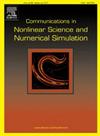Dynamic model of air spring based McKibben pneumatic artificial muscle
IF 3.8
2区 数学
Q1 MATHEMATICS, APPLIED
Communications in Nonlinear Science and Numerical Simulation
Pub Date : 2025-04-03
DOI:10.1016/j.cnsns.2025.108829
引用次数: 0
Abstract
It is necessary to have an accurate nonlinear dynamic model for purpose of design of optimization of systems constructed by pneumatic artificial muscles (PAM) based on McKibben structure. Hence, this paper will develop an accurate dynamic model of PAM. As known, PAM tube is made of the rubber and it is also reinforced by metal fibers wrapping around the tube. In order to study comprehensively, the prediction model will consider the effects of the thermodynamic of air inside PAM, simultaneously the effects of friction between fibers and rubber, and viscoelasticity of the PAM tube material are taken account into. Firstly, the structure parameters of the proposed model comprising the effectiveness volume and its rates will be attained through geometrical analysis and experimental evaluation. Then, the effects of friction and viscoelasticity of the PAM tube on the hysteresis dynamic response of PAM will be also taken into account through proposing the hysteresis dynamic model including a fractional Maxwell model parallel with smooth friction model. From dynamic analysis, the dynamic stiffness model is attained and analyzed in domain frequency comprising the storage stiffness and loss stiffness. Finally, comparison between the proposed model and experimental results is realized subjected to harmonic displacement excitation. The results proved the effectiveness of the proposed model. The studied finding is useful insight into applications of PAM in vibration isolator as well as other engineering purposes.
基于空气弹簧的McKibben气动人工肌肉动力学模型
为了对基于McKibben结构的气动人工肌肉(PAM)系统进行优化设计,有必要建立精确的非线性动力学模型。因此,本文将建立一个准确的PAM动态模型。众所周知,PAM管是由橡胶制成的,它也被金属纤维包裹在管上。为了研究的更全面,该预测模型将考虑PAM内部空气热力学的影响,同时考虑纤维与橡胶之间摩擦的影响,以及PAM管材的粘弹性。首先,通过几何分析和实验评估,得到模型的有效体积和效率的结构参数;然后,考虑PAM管的摩擦和粘弹性对PAM滞回动态响应的影响,提出了包含与光滑摩擦模型平行的分数阶Maxwell模型的滞回动态模型。从动力分析出发,建立了动力刚度模型,并在存储刚度和损耗刚度组成的域频率上进行了分析。最后,在谐波位移激励下,将模型与实验结果进行了比较。结果证明了该模型的有效性。研究结果对PAM在隔振器及其他工程中的应用具有重要的指导意义。
本文章由计算机程序翻译,如有差异,请以英文原文为准。
求助全文
约1分钟内获得全文
求助全文
来源期刊

Communications in Nonlinear Science and Numerical Simulation
MATHEMATICS, APPLIED-MATHEMATICS, INTERDISCIPLINARY APPLICATIONS
CiteScore
6.80
自引率
7.70%
发文量
378
审稿时长
78 days
期刊介绍:
The journal publishes original research findings on experimental observation, mathematical modeling, theoretical analysis and numerical simulation, for more accurate description, better prediction or novel application, of nonlinear phenomena in science and engineering. It offers a venue for researchers to make rapid exchange of ideas and techniques in nonlinear science and complexity.
The submission of manuscripts with cross-disciplinary approaches in nonlinear science and complexity is particularly encouraged.
Topics of interest:
Nonlinear differential or delay equations, Lie group analysis and asymptotic methods, Discontinuous systems, Fractals, Fractional calculus and dynamics, Nonlinear effects in quantum mechanics, Nonlinear stochastic processes, Experimental nonlinear science, Time-series and signal analysis, Computational methods and simulations in nonlinear science and engineering, Control of dynamical systems, Synchronization, Lyapunov analysis, High-dimensional chaos and turbulence, Chaos in Hamiltonian systems, Integrable systems and solitons, Collective behavior in many-body systems, Biological physics and networks, Nonlinear mechanical systems, Complex systems and complexity.
No length limitation for contributions is set, but only concisely written manuscripts are published. Brief papers are published on the basis of Rapid Communications. Discussions of previously published papers are welcome.
 求助内容:
求助内容: 应助结果提醒方式:
应助结果提醒方式:


